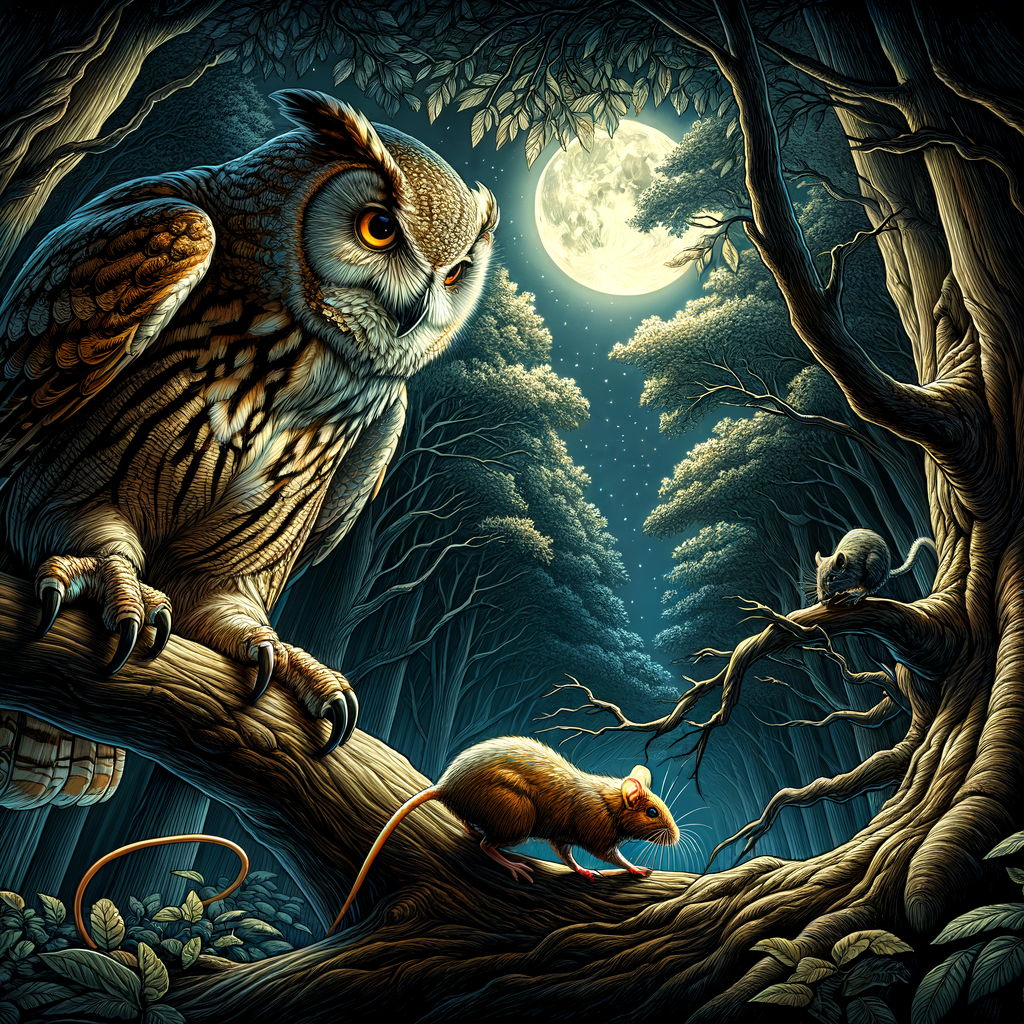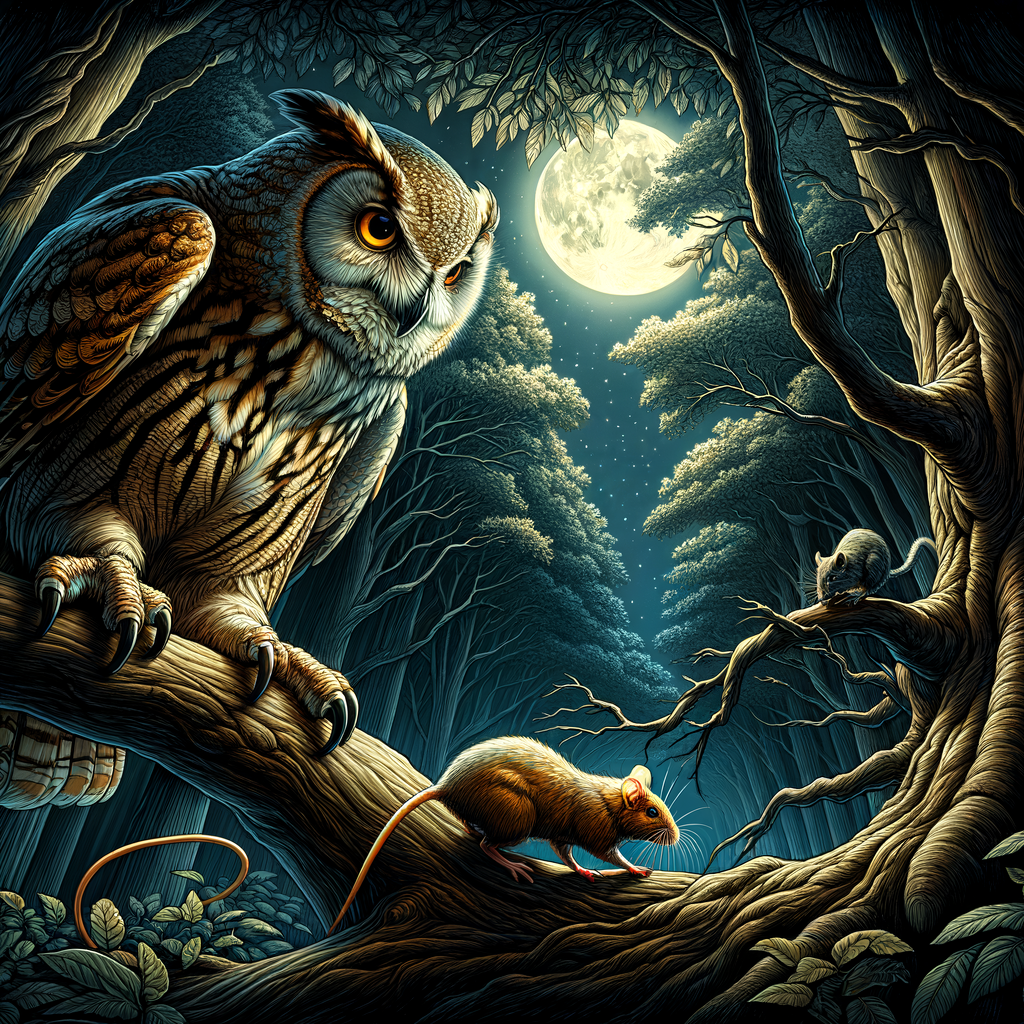
Introduction: Owls and Prey Behavior
-
- Overview of the topic
Owls are fascinating birds of prey known for their silent flight and keen hunting skills. They are nocturnal, meaning they hunt at night. Understanding how owls hunt and how their prey behaves is important for many reasons.
-
- Importance of understanding predator-prey dynamics
Knowing about predator-prey dynamics helps us learn how animals survive in the wild. It shows us how owls and their prey interact. This knowledge is crucial for scientists and wildlife managers. It helps in conserving species and maintaining the balance of nature.
Owl Hunting Impact: Predator-Prey Dynamics
Owl Influence on Prey
- How owls impact prey behaviorThey hunt at night, using their sharp vision and hearing. This makes prey animals very cautious. Small animals, like mice, change their behavior to avoid being eaten. They might stay hidden more often or move very quickly.
- Case study: Owl predation effects on small mammal populationsScientists studied how owls affect small mammals. In one study, they found that when owls are around, the number of small mammals goes down. For example, in a forest with many owls, there were fewer mice and voles. This shows that owls play a big role in controlling small mammal populations.
Nocturnal Predators and Prey: A Unique Dynamic
The Role of Owls in the Ecosystem
- Owls as Apex Predators: Owls are at the top of the food chain in many ecosystems. They hunt at night, using their excellent vision and hearing to catch prey. This makes them very effective hunters.
- Impact of Owl Predation on Ecosystem Balance: Owls help keep the ecosystem balanced by controlling the population of small animals like mice and insects. If there were too many of these small animals, they could harm crops and spread disease. By hunting them, owls help keep everything in check.
Prey Animal Behavior Changes: Adapting to Owl Predation
Prey Adaptation Strategies
- Behavioral changes in prey animals:Prey animals, like mice and rabbits, change their behavior to avoid being caught by owls. These changes help them survive. For example, some animals become more active during the day when owls are less likely to hunt. Others may choose safer places to hide or move more quietly to avoid detection.
- Case study: Evolutionary adaptations in response to owl predation:Over time, some prey animals have developed special traits to escape owls. For instance, certain species of mice have evolved to have better hearing. This helps them detect the sound of an owl’s wings. Another example is the coloration of some animals, which helps them blend into their surroundings, making it harder for owls to spot them.
Adaptation Example Better Hearing Some mice can hear the quietest sounds, helping them avoid owls. Camouflage Rabbits with fur that matches their environment are harder for owls to see.
Predator-Prey Interactions: The Balance of Nature
The Impact of Owls on Prey Adaptation
- How owls shape the behavior and evolution of prey animals: Owls are skilled hunters, especially at night. Their presence forces prey animals to adapt in various ways. For example, mice and rabbits become more alert and change their feeding times to avoid being caught. Some animals even develop better hearing or camouflage to survive.
- Key takeaways: The importance of predator-prey dynamics in nature: Predator-prey relationships are crucial for a healthy ecosystem. They help control animal populations and keep nature in balance. Without predators like owls, prey animals could overpopulate, leading to food shortages and habitat destruction. This balance ensures that all species can thrive.
Conclusion: Owls’ Role in Shaping Prey Behavior
- Summary of the article’s main points: Throughout this article, we have explored how owls, as nocturnal predators, impact the behavior of their prey. Owls hunt at night, which forces prey animals to adapt their habits to avoid being caught. This includes changes in their activity patterns, hiding behaviors, and even physical adaptations. The predator-prey dynamics between owls and their prey create a unique balance in nature, ensuring the survival of both species.
- Final thoughts on the importance of understanding owls’ impact on prey behavior: Understanding how owls influence the behavior of their prey is crucial for appreciating the delicate balance of ecosystems. By studying these interactions, we can better protect both owls and their prey, ensuring that natural habitats remain healthy and thriving. This knowledge also helps us understand the broader implications of predator-prey relationships in the animal kingdom.






